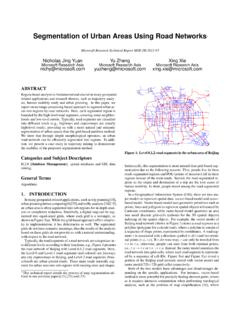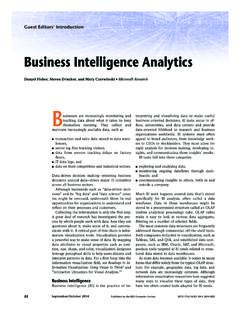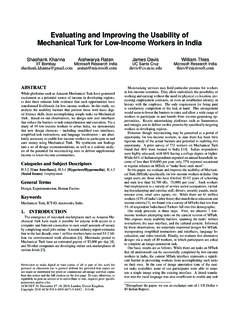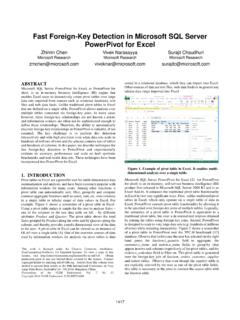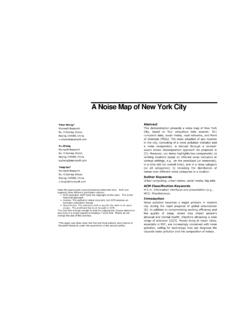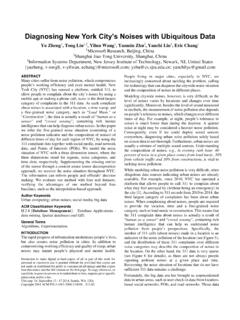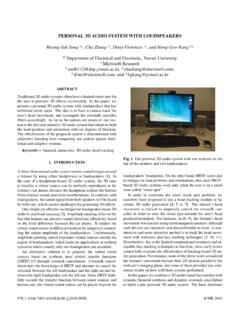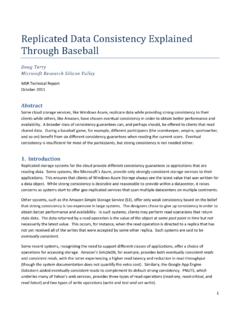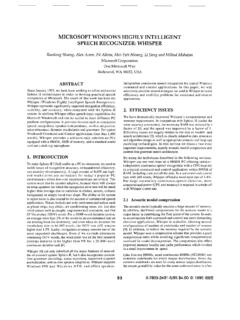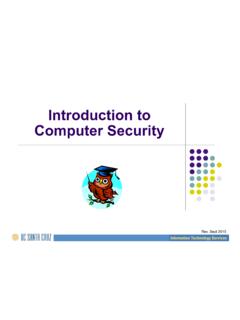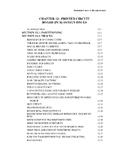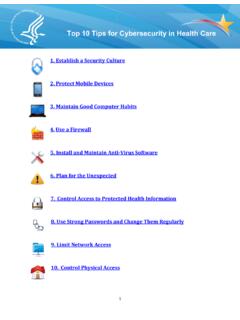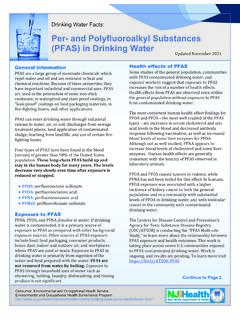Transcription of Seven Properties of Highly Secure Devices (2nd Edition)
1 1 The Seven Properties of Highly Secured Devices (2nd Edition) 1,2 Galen Hunt, George Letey, and Edmund B. Nightingale Microsoft Azure Sphere Team ABSTRACT Many organizations building and deploying IoT Devices largely underestimate the critical societal need to embody the highest levels of cybersecurity in every network-connected device. Every connected child s toy, every household s connected appliances, and every industry s connected equipment needs to be secured against network-based attacks. Until now, high development and maintenance costs have limited strong security to high-cost or high-margin Devices . Our mission is to bring high-integrity cybersecurity to every IoT device.
2 We are especially concerned with the tens of billions of Devices powered by microcontrollers. This class of Devices is particularly ill-prepared for the security challenges of internet connectivity. Insufficient investments in the security needs of these and other price-sensitive Devices have left consumers, enterprises, and society critically exposed to device security and privacy failures. This paper makes two contributions to the field of device security. First, we identify Seven Properties we assert are required for all Highly secured Devices . Second, we describe our experiment working with a silicon partner to create a prototype Highly secured microcontroller, codenamed Sopris.
3 We evaluate Sopris against the Seven Properties framework and in a penetration test utilizing a red team of 150 top-tier hackers. Our experimental results suggest that even the most price-sensitive Devices can and should be redesigned to achieve the high levels of device security critical to society s safety. 1. INTRODUCTION The next decade promises the universal democratization of connectivity to every device. Significant drops in the cost of connectivity mean that every form of electrical device every child s toy, every household s appliances, and every industry s equipment will connect to the Internet. This Internet of Things (IoT) will drive huge economic efficiencies; it will enable countless innovations as digital transformation reaches across fields from childcare to eldercare, from hospitality to mining, from education to transportation.
4 Although no person can foresee the full impact of universal device connectivity, anticipation of this new frontier is widespread [1] [2]. In our experience, the organizations and individuals building and deploying IoT Devices largely underestimate the critical need for the highest levels of cybersecurity in every network-connected device. Even the most mundane device can become dangerous when compromised over the Internet: a toy can spy or deceive [3], an appliance can self-destruct or launch a denial of service [4], a piece of equipment can maim or destroy [5]. With risks to life, limb, reputation, and property so high, single-line-of-defense and second-best solutions are not enough.
5 Because many connected Devices will be deployed as components of larger IoT systems, the compromise of the even the most innocent device can easily lead to compounding risks through data pollution attacks, lateral movement attacks, or denial-of-service attacks. 1 This edition adds results from the Sopris Security Challenge and improvements to the text from the 1st edition based on feedback from the device security community. Key changes in the text are introduced with footnotes. 2 We use the past-tense, secured , to acknowledge that the challenges of securing a device require constant improvement; yesterday s security may be insecure today due to newly emerged security threats. 2 We don t intend to be alarmists.
6 Although the state-of-the-art cybersecurity of internet-connected Devices leaves much to be desired, we are quite optimistic for the future of device security. We believe it is within the realm of achievability for all Devices , even the most price sensitive, to be engineered with sufficient security to merit trust even in the face of aggressive attacks from determined hackers. Our fears and our hopes for connected device security are grounded in decades of Microsoft experience as an active defender in the Internet security battle. Early attacks against networked PCs motivated Microsoft to pioneer remote update of Devices in the field with Windows 95 [6]. Escalating attacks motivated Microsoft to pioneer automated error reporting of security attacks and automated evidence analysis with Windows XP [7].
7 The desire to avoid in-field vulnerabilities continues to motivate Microsoft to create technologies and tools to detect and address vulnerabilities at design time [8] [9]. The goal of our work is to enable device manufacturers, regardless of industry, to incorporate the highest levels of cybersecurity in every network-connected device they build; and, by extension, to allow every consumer and organization to choose to deploy and use only Devices with high levels of security. In our studies of existing Devices and their cybersecurity capabilities, we have identified Seven Properties required for Highly secured, network-connected Devices : a hardware root of trust, defense in depth3, a small trusted computing base, dynamic compartments4, password-less authentication5, error reporting6, and renewable security (see Section 2).
8 For any network-connected device to remain secured, it must possess or be provided with all Seven of these Properties . To implement these Seven Properties , the hardware and software (firmware) of the device must work together, with device security rooted in hardware and guarded by continuously improving security software. Where one or more of the Seven Properties are not built into the device or have a substandard implementation, those Properties must be augmented externally with additional human-based practices and processes often at considerable expense. To give just one example, a device lacking fully automated renewable security must be manually updated a practice that may require expensive truck rolls of technicians to deploy updates in the field in the event of the inevitable emergence of a significant new security threat.
9 In our experience, this last point is critical because we find device manufacturers persistently underestimate the frequency of updates required by the emergence of new security threats even the most well-designed Devices typically require multiple updates per year. We find these cybersecurity Properties especially lacking in microcontroller-based Devices . Some microcontroller families are beginning to evolve security features in hardware, such as cryptographic engines or trusted execution environments. However, these improvements don t go far enough. Providing cryptographic acceleration or private key storage isn t enough to create a Highly secured device if the microcontroller doesn t also allow defense in depth or dynamic compartments.
10 Most 3 Defense in depth was reordered before small trusted computing base as we ve found the latter often easier to explain after the former was defined. Likewise, the reordering of renewable security after error reporting . 4 Compartmentalization was changed to dynamic compartments to express the needed ability to change compartment boundaries over the lifetime of a device in the face of escalating security threats. 5 Certificate-based authentication was changed to password-less authentication to remove the implied dependency on a specific implementation technology. 6 Failure reporting was changed to error reporting to express that not all errors lead to failures.
